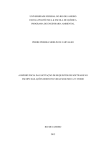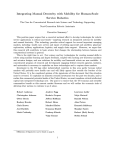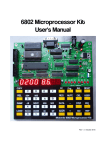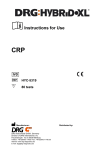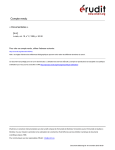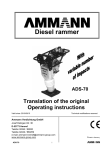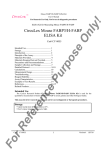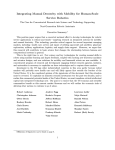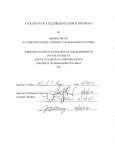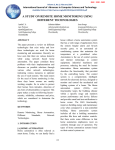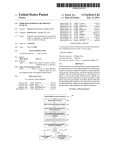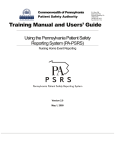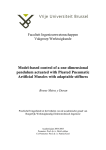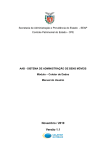Download CY-8071 High-Sensitivity CRP ELISA Kit
Transcript
High-Sensitivity CRP ELISA Kit User’s Manual For Research Use Only, Not for use in diagnostic procedures ELISA Kit for Measuring Human High-Sensitivity CRP On ly! CircuLex TM CircuLex High-Sensitivity CRP ELISA Kit Pu rp Intended Use................................................ 1 Storage......................................................... 1 Introduction.................................................. 2 Principle of the Assay.................................. 2-3 Materials Provided....................................... 3 Materials Required but not Provided........... 4 Precautions and Recommendations............. 5 Sample Collection and Storage.....................6 Detailed Protocol......................................... 7-9 Calculations.................................…............ 9 Measurement Range.................................... 9 Troubleshooting........................................... 9 Reagent Stability......................................... 10 Assay Characteristics.................................. 10-12 Example of Test Results..............................13 References................................................... 14 Related Products......................................... 15 os e Cat# CY-8071 ce Intended Use The CycLex Research Product CircuLex High-Sensitivity CRP ELISA Kit is used for the quantitative measurement of Human C-reactive protein (CRP) in serum, plasma and other biological media. en This assay kit is for research use only and not for use in diagnostic or therapeutic procedures. Storage rR ef er • Upon receipt store all components at 4°C. • Don’t expose reagents to excessive light. Fo Cat#: CY-8071 1 Version#: 140318 High-Sensitivity CRP ELISA Kit User’s Manual For Research Use Only, Not for use in diagnostic procedures On ly! CircuLex TM Introduction Principle of the Assay Pu rp os e C-Reactive protein (CRP) is a pentameric acute phase reactant that is synthesized by the liver. Its production is controlled primarily by interleukin-6. The serum CRP concentration may increase by up to 1000-fold with infection, ischemia, trauma, surgery, and other acute inflammatory events (1). Thus CRP can be used as an extremely sensitive systemic marker of inflammation. Especially in situations where microbiological diagnosis is difficult or too slow in the clinical context, CRP measurements can be used to infer the presence of bacterial infection (2). Ligand-bound or aggregated CRP binds C1q and in so doing activates the classical complement pathway (3). Although primarily synthesized in hepatocytes, there is evidence for local expression of CRP in macrophages of the lung and the brain (4–6). In atherosclerotic plaques, it has been found associated with complement proteins and within foam cells (7, 8). A growing number of studies suggest that CRP is an independent risk factor for atherosclerotic vascular disease. Plasma CRP concentrations in the highest quartile are associated, depending on the subject group, with 1.5- to 7-fold increases in relative risk of symptomatic atherosclerosis (1, 9) The baseline plasma concentration of C-reactive protein predicts the risk of future myocardial infarction and stroke (10) and is associated with a poor prognosis in unstable angina (11–13). Plasma CRP levels are also strongly associated with obesity and obesity-related diseases, including insulin resistance, diabetes mellitus, and hyperlipidemia (14–17). Although a recent report indicated that the plasma CRP level decreased during weight reduction (17), the precise interaction of CRP with obesity has not been fully elucidated. rR ef er en ce The CircuLex High-Sensitivity CRP ELISA Kit employs the quantitative sandwich enzyme immunoassay technique. An antibody specific for Human CRP has been pre-coated onto a microplate. Standards and samples are pipetted into the wells and the immobilized antibody binds any Human CRP present. After washing away any unbound substances, an HRP conjugated antibody specific for Human CRP is added to the wells. Following a wash to remove any unbound antibody HRP conjugate, the remaining conjugate is allowed to react with the substrate H2O2-tetramethylbenzidine. The reaction is stopped by addition of acidic solution and absorbance of the resulting yellow product is measured at 450 nm. The absorbance is proportional to the concentration of Human CRP. A standard curve is constructed by plotting absorbance values versus Human CRP concentrations of calibrators, and concentrations of unknown samples are determined using this standard curve. The CircuLex High-Sensitivity CRP ELISA Kit is designed to measure the concentration of Human CRP from cell lysate of cultured human cell lines, cell culture conditioned medium and human serum/plasma. Fo Cat#: CY-8071 2 Version#: 140318 High-Sensitivity CRP ELISA Kit User’s Manual For Research Use Only, Not for use in diagnostic procedures Summary of Procedure Add 100 µL of diluted sample to the wells Incubate for 1 hour at room temp. Wash the wells Add 100 µL of HRP conjugated anti-Human CRP antibody On ly! CircuLex TM Wash the wells Add 100 µL of Substrate Reagent Pu rp Add 100 µL of Stop Solution os e Incubate for 1 hour at room temp. Measure absorbance at 450 nm Materials Provided All samples and standards should be assayed in duplicate. The following components are supplied and are sufficient for the one 96-well microplate kit. ce Microplate: One microplate supplied ready to use, with 96 wells (12 strips of 8-wells) in a foil, zip-lock bag with a desiccant pack. Wells are coated with anti-Human CRP antibody as a capture antibody. 10X Wash Buffer: One 100 mL bottle of 10X buffer containing 2%Tween®-20 en Dilution Buffer: One bottle containing 50 mL of 1X buffer; use for sample dilution. Ready to use. Human CRP Standard (*): One vial containing 19 ng of lyophilized Human CRP er HRP conjugated Detection Antibody: One vial containing 12 mL of HRP (horseradish peroxidase) conjugated anti-Human CRP antibody. Ready to use. Substrate Reagent: One bottle containing 20 mL of the chromogenic substrate, tetra-methylbenzidine (TMB). Ready to use ( ) ef Stop Solution: One bottle containing 20 mL of 1 N H2SO4. Ready to use. rR * It contains human sera. Handle as if capable of transmitting infectious agents. The sera were tested and found to be negative for HIV, HBV and HCV. However, because no test method can offer complete assurance that HIV, HBV, HCV or other infectious agents are absent, this component should be handled at the Bio-safety Level 2 (BSL 2) as recommended for any potentially infectious human serum or blood specimen in the CDC / NIH manual "Biosafety in microbiological and Biomedical Laboratories". Fo Cat#: CY-8071 3 Version#: 140318 High-Sensitivity CRP ELISA Kit User’s Manual For Research Use Only, Not for use in diagnostic procedures On ly! CircuLex TM Materials Required but not Provided • Pipettors: 2-20 µL, 20-200 µL and 200-1000 µL precision pipettors with disposable tips. • Precision repeating pipettor • Orbital microplate shaker • Microcentrifuge and tubes for sample preparation. os e • Vortex mixer • Microplate washer: optional (Manual washing is possible but not preferable) • Plate reader capable of measuring absorbance in 96-well plates at dual wavelengths of 450 nm/540 nm. Dual wavelengths of 450/550 or 450/595 nm can also be used. The plate can also be read at a single wavelength of 450 nm, which will give a somewhat higher reading. • 500 or 1000 mL graduated cylinder • Reagent reservoirs • Deionized water of the highest quality rR ef er en ce • Disposable paper towels Pu rp • Software package facilitating data generation and analysis :optional Fo Cat#: CY-8071 4 Version#: 140318 High-Sensitivity CRP ELISA Kit User’s Manual For Research Use Only, Not for use in diagnostic procedures Precautions and Recommendations • Allow all the components to come to room temperature before use. On ly! CircuLex TM • All microplate strips that are not immediately required should be returned to the zip-lock pouch, which must be carefully resealed to avoid moisture absorption. • Do not use kit components beyond the indicated kit expiration date. os e • Use only the microtiter wells provided with the kit. • Rinse all detergent residue from glassware. • Use deionized water of the highest quality. • Do not mix reagents from different kits. Pu rp • The buffers and reagents in this kit may contain preservatives or other chemicals. Care should be taken to avoid direct contact with these reagents. • Do not mouth pipette or ingest any of the reagents. • Do not smoke, eat, or drink when performing the assay or in areas where samples or reagents are handled. • Dispose of tetra-methylbenzidine (TMB) containing solutions in compliance with local regulations. • Avoid contact with the acidic Stop Solution and Substrate Solution, which contains hydrogen peroxide. ce • Wear gloves and eye protection when handling immunodiagnostic materials and samples of human origin, and these reagents. In case of contact with the Stop Solution and the Substrate Solution, wash skin thoroughly with water and seek medical attention, when necessary. er en • “Human CRP Standard” contains human sera. Handle as if capable of transmitting infectious agents. The sera were tested and found to be negative for HIV, HBV and HCV. However, because no test method can offer complete assurance that HIV, HBV, HCV or other infectious agents are absent, this component should be handled at the Bio-safety Level 2 (BSL 2) as recommended for any potentially infectious human serum or blood specimen in the CDC / NIH manual "Biosafety in microbiological and Biomedical Laboratories". • Biological samples may be contaminated with infectious agents. Do not ingest, expose to open wounds or breathe aerosols. Wear protective gloves and dispose of biological samples properly. rR ef • Sulfuric Acid is a strong acid. Wear disposable gloves and eye protection when handling Stop Solution. Fo Cat#: CY-8071 5 Version#: 140318 High-Sensitivity CRP ELISA Kit User’s Manual For Research Use Only, Not for use in diagnostic procedures On ly! CircuLex TM Sample Collection and Storage Serum: Use a serum separator tube and allow samples to clot for 60 ± 30 minutes. Centrifuge the samples at 4°C for 10 minutes at 1,000 x g. Remove serum and assay immediately or store samples on ice for up to 6 hours before assaying. Aliquots of serum may also be stored at below -70°C for extended periods of time. Avoid repeated freeze-thaw cycles. os e Plasma: Collect plasma using EDTA-Na2 or heparin as the anticoagulant. If possible, collect the plasma into a mixture of EDTA-Na2 and Futhan5 to stabilize the sample against spontaneous in vitro complement activation. Immediately centrifuge samples at 4°C for 15 minutes at 1,000 x g. Assay immediately or store samples on ice for up to 6 hours before assaying. Aliquots of plasma may also be stored at below -70°C for extended periods of time. Avoid repeated freeze-thaw cycles. Note: Citrate plasma has not been validated for use in this assay. rR ef er en ce Pu rp Other biological samples: Remove any particulates by centrifugation and assay immediately or aliquot and store samples at below -70°C. Avoid repeated freeze-thaw cycles. Fo Cat#: CY-8071 6 Version#: 140318 High-Sensitivity CRP ELISA Kit User’s Manual For Research Use Only, Not for use in diagnostic procedures On ly! CircuLex TM Detailed Protocol The CycLex Research Product CircuLex High-Sensitivity CRP ELISA Kit is provided with removable strips of wells so the assay can be carried out on separate occasions using only the number of strips required for the particular determination. Since experimental conditions may vary, an aliquot of the Human CRP Standard within the kit, should be included in each assay as a calibrator. Disposable pipette tips and reagent troughs should be used for all liquid transfers to avoid cross-contamination of reagents or samples. Preparation of Working Solutions os e All reagents need to be brought to room temperature prior to the assay. Assay reagents are supplied ready-to-use, with the exception of 10X Wash Buffer and Human CRP Standard. 1. Prepare a working solution of Wash Buffer by adding 100 mL of the 10X Wash Buffer to 900 mL of deionized (distilled) water. Mix well. Store at 4°C for two weeks or -20°C for long-term storage. Pu rp 2. Reconstitute Human CRP Standard with 1.25 mL of Dilution Buffer. The concentration of the human CRP in vial should be 15.2 ng/mL, which is referred as a Master Standard of human CRP. Prepare Standard Solutions as follows: Use the Master Standard to produce a dilution series (below). Mix each tube thoroughly before the next transfer. The 3,800 pg/mL standard (Std.1) serves as the high standard. The Dilution Buffer serves as the zero standard (Blank). Volume of Standard 150 µL of Master Standard 300 µL of Std. 1 (3,800 pg/mL) 300 µL of Std. 2 (1,900 pg/mL) 300 µL of Std. 3 (950 pg/mL) 300 µL of Std. 4 (475 pg/mL) 300 µL of Std. 5 (237.5pg/mL) 300 µL of Std. 6 (118.8 pg/mL) ce Std.1 Std.2 Std.3 Std.4 Std.5 Std.6 Std.7 Blank en - Dilution Buffer 450 µL 300 µL 300 µL 300 µL 300 µL 300 µL 300 µL 300 µL Concentration 3,800 pg/mL 1,900 pg/mL 950 pg/mL 475 pg/mL 237.5 pg/mL 118.8 pg/mL 59.4 pg/mL 0 pg/mL er Note: Do not use a Repeating pipette. Change tips for every dilution. Wet tip with Dilution Buffer before dispensing. Unused portions of Standards should be aliquoted and stored at below -70°C immediately. Avoid multiple freeze and thaw cycles. Sample Preparation ef • Serum and plasma samples require a 2,500-fold dilution. e.g. First: Make 50-fold dilution (2 µL of sample + 98 µL of Dilution Buffer) Second: Make 2,500-fold dilution (5 µL of 50-fold diluted sample + 245 µL Dilution Buffer) Don’t store diluted samples. rR • Other biological samples require 10-, 100- and 1,000-fold dilution. Fo Cat#: CY-8071 7 Version#: 140318 High-Sensitivity CRP ELISA Kit User’s Manual For Research Use Only, Not for use in diagnostic procedures Assay Procedure On ly! CircuLex TM 1. Prepare the assay protocol, assigning the appropriate wells for setting up Standard solutions, diluted patient specimens and any internal laboratory controls in duplicate. Remove the appropriate number of microtiter wells from the foil pouch and place them into the well holder. Return any unused wells to the foil pouch, refold, seal with tape and store at 4°C. 2. Dilute samples with Dilution Buffer. (See “Sample Preparation” above.) os e 3. Pipette 100 µL of Standard Solutions (Std1-Std7, Blank) and diluted samples in duplicates, into the appropriate wells. 4. Incubate the plate at room temperature (ca.25°C) for 1 hour, shaking at ca. 300 rpm on an orbital microplate shaker. 5. Wash 4-times by filling each well with Wash Buffer (350 µL) using a squirt bottle, multi-channel pipette, manifold dispenser or microplate washer. Pu rp 6. Add 100 µL of HRP conjugated Detection Antibody into each well. 7. Incubate the plate at room temperature (ca.25°C) for 1 hour, shaking at ca. 300 rpm on an orbital microplate shaker. 8. Wash 4-times by filling each well with Wash Buffer (350 µL) using a squirt bottle, multi-channel pipette, manifold dispenser or microplate washer. 9. Add 100 µL of Substrate Reagent. Avoid exposing the microtiter plate to direct sunlight. Covering the plate with e.g. aluminum foil is recommended. Return Substrate Reagent to 4°C immediately after the necessary volume is removed ce 10. Incubate the plate at room temperature (ca. 25°C) for 10-20 minutes, shaking at ca. 300 rpm on an orbital microplate shaker. The incubation time may be extended up to 30 minutes if the reaction temperature is below than 20°C. en 11. Add 100 µL of Stop Solution to each well in the same order as the previously added Substrate Reagent. er 12. Measure absorbance in each well using a spectrophotometric microplate reader at dual wavelengths of 450/540 nm. Dual wavelengths of 450/550 or 450/595 nm can also be used. Read the microplate at 450 nm if only a single wavelength can be used. Wells must be read within 30 minutes of adding the Stop Solution. ef Note-1: Complete removal of liquid at each step is essential to good performance. After the last wash, remove any remaining Wash Buffer by aspirating or decanting. Invert the plate and blot it against clean paper towels. rR Note-2: Reliable standard curves are obtained when either O.D. values do not exceed 0.2 units for the blank (zero concentration), or 2.5 units for the highest standard concentration. The plate should be monitored at 5-minute intervals for approximately 30 minutes. Note-3: If the microplate reader is not capable of reading absorbance greater than the absorbance of the Fo Cat#: CY-8071 8 Version#: 140318 High-Sensitivity CRP ELISA Kit User’s Manual For Research Use Only, Not for use in diagnostic procedures On ly! CircuLex TM highest standard, perform a second reading at 405 nm. A new standard curve, constructed using the values measured at 405 nm, is used to determine Human CRP concentration of off-scale samples. The readings at 405 nm should not replace the on-scale readings at 450 nm. Calculations os e Average the duplicate readings for each standard, control, and sample and subtract the average zero standard optical density. Plot the optical density for the standards versus the concentration of the standards and draw the best curve. To determine the Human CRP concentration of each sample, first find the absorbance value on the y-axis and extend a horizontal line to the standard curve. At the point of intersection, extend a vertical line to the x-axis and read the corresponding Human CRP concentration. If the samples have been diluted, the concentration read from the standard curve must be multiplied by the dilution factor. 1. The results of unknown samples can be calculated with any computer program having a 5-parameter logistic function. It is important to make an appropriate mathematical adjustment to accommodate for the dilution factor. Pu rp 2. Most microtiter plate readers perform automatic calculations of analyte concentration. The calibration curve is constructed by plotting the absorbance (Y) of calibrators versus log of the known concentration (X) of calibrators, using the four-parameter function. Alternatively, the logit log function can be used to linearize the calibration curve (i.e. logit of absorbance (Y) is plotted versus log of the known concentration (X) of calibrators). Measurement Range Troubleshooting ce The measurement range is 59.4 µg/mL to 3,800 µg/mL. Any sample reading higher than the highest standard should be diluted with Dilution Buffer in higher dilution and re-assayed. Dilution factors need to be taken into consideration in calculating the human CPR concentration. en 1. The Human CRP Standard should be run in duplicate, using the protocol described in the Detailed Protocol. Incubation times or temperatures significantly different from those specified may give erroneous results. er 2. Poor duplicates, accompanied by elevated values for wells containing no sample, indicate insufficient washing. If all instructions in the Detailed Protocol were followed accurately, such results indicate a need for washer maintenance. rR ef 3. Overall low signal may indicate that desiccation of the plate has occurred between the final wash and addition of Substrate Reagent. Do not allow the plate to dry out. Add Substrate Reagent immediately after wash. Fo Cat#: CY-8071 9 Version#: 140318 High-Sensitivity CRP ELISA Kit User’s Manual For Research Use Only, Not for use in diagnostic procedures Reagent Stability On ly! CircuLex TM All of the reagents included in the CycLex Research Product CircuLex High-Sensitivity CRP ELISA Kit have been tested for stability. Reagents should not be used beyond the stated expiration date. Upon receipt, kit reagents should be stored at 4°C, except the reconstituted Human CRP Standard must be stored at below -70°C. Coated assay plates should be stored in the original foil bag sealed by the zip lock and containing a desiccant pack. For research use only, not for use in diagnostic or therapeutic procedures os e Assay Characteristics 1. Sensitivity The limit of detection (defined as such a concentration of Human CRP giving absorbance higher than mean absorbance of blank* plus three standard deviations of the absorbance of blank: A blank + 3*SD blank) is better than 28.6 pg/mL of sample. Pu rp * Dilution Buffer is pipetted into blank wells. Eighty assays were evaluated and the minimum detectable dose (MDD) of Human CRP ranged from 21.5- 34.3 pg/mL. The mean MDD was 28.6 pg/mL. The MDD was determined by adding three standard deviations to the mean optical density value of twenty zero standard replicates and calculating the corresponding concentration. Typical standard curve ce 2.5 2.0 1.0 er 0.5 en A450 1.5 0.0 rR ef 0.0 Fo Cat#: CY-8071 1.0 2.0 Human CRP conc. (ng/ml) 10 3.0 4.0 Version#: 140318 High-Sensitivity CRP ELISA Kit User’s Manual For Research Use Only, Not for use in diagnostic procedures On ly! CircuLex TM 2. Specificity The antibodies in the CircuLex High-Sensitivity CRP ELISA Kit are highly specific of Human CRP, with no detectable cross-reactivity to other serum protein and to other acute phase reactant including SAA. 3. Precision • Intra-assay (Within-Run, n=12) CV = 3.8, 1.8, 2.6 % Pu rp CRP conc.in human Serum (ug/ml) B C 4.47 7.83 4.29 8.57 4.27 8.24 4.26 8.07 4.28 8.41 4.38 8.54 4.37 8.40 4.44 8.30 4.23 8.18 4.30 8.23 4.37 8.27 4.37 8.56 4.47 8.57 4.23 7.83 4.34 8.30 0.08 0.22 1.8% 2.6% ce 1 2 3 4 5 6 7 8 9 10 11 12 MAX. MIN. MEAN S.D. C.V. A 1.18 1.22 1.21 1.28 1.24 1.32 1.24 1.20 1.28 1.31 1.32 1.30 1.32 1.18 1.26 0.05 3.8% os e Intra-assay Precision (Precision within an assay) Three samples of known concentration were tested twelve times on one plate to assess intra-assay precision. en Inter-assay Precision (Precision between assays) Three samples of known concentration were tested in five separate assays to assess inter-assay precision. • Inter-assay (Run-to-Run, n=5) CV = 5.2, 5.2, 2.6 % CRP conc. (ug/ml) rR ef er Day 1 2 3 4 5 MAX. MIN. MEAN S.D. C.V. Fo Cat#: CY-8071 Serum 1 1.16 1.14 1.01 1.11 1.11 1.16 1.01 1.10 0.058 5.2% Serum 2 3.94 3.88 3.58 3.76 3.48 3.94 3.48 3.73 0.195 5.2% 11 Serum 3 7.29 7.33 7.44 7.13 6.97 7.44 6.97 7.23 0.186 2.6% Version#: 140318 On ly! CircuLex High-Sensitivity CRP ELISA Kit User’s Manual For Research Use Only, Not for use in diagnostic procedures TM 4. Spiking Recover Serum samples were spiked with different amounts of Human CRP and assayed. The recovery of Human CRP spiked to levels throughout the range of the assay was evaluated. Sample Average % Recovery Range Cell culture media (n=4) • Recovery = 104, 96, 112 % os e 5. Linearity To assess the linearity of the assay, samples containing and/or spiked with high concentrations of Human CRP were serially diluted with the Dilution Buffer to produce samples with values within the dynamic range of the assay. The linearity of the assay 4.0 Pu rp ● Serum A ▲ Serum B ◆ Serum C h u C RP c o n c . ( n g/ m l) 3.0 2.0 0.0 0.5 1 1.5 2 2.5 3 3.5 4 4.5 D ilu tio n ratio ( / 1 0 ,0 0 0 ) rR ef er en 0 ce 1.0 Fo Cat#: CY-8071 12 Version#: 140318 High-Sensitivity CRP ELISA Kit User’s Manual For Research Use Only, Not for use in diagnostic procedures On ly! CircuLex TM Example of Test Results Fig.1 Human CRP level in sera from 63 healthy volunteers os e 40 20 Pu rp Number 30 10 0 0.5 ~ 1 1~5 5 ~ 10 CRP conc. (ug/ml) ≧10 rR ef er en ce ≦0.5 Fo Cat#: CY-8071 13 Version#: 140318 High-Sensitivity CRP ELISA Kit User’s Manual For Research Use Only, Not for use in diagnostic procedures On ly! CircuLex TM References rR ef er en ce Pu rp os e 1. Westhuyzen J, Healy H. Biology and relevance of C-reactive protein in cardiovascular and renal disease. Ann Clin Lab Sci. 2000; 30: 133–143. 2. Nakayama, T. et al. (1993) Clinical Chemistry. 39(2): 293-297. 3. Du Clos TW. Function of C-reactive protein. Ann Med. 2000; 32: 274–278. 4. Dong Q, Wright JR. Expression of C-reactive protein by alveolar macrophages. J Immunol. 1996; 156: 4815–4820. 5. Gould JM, Weiser JN. Expression of C-reactive protein in the human respiratory tract. Infect Immun. 2001; 69: 1747–1754. 6. Yasojima K, Schwab C, McGeer EG, et al. Generation of C-reactive protein and complement components in atherosclerotic plaques. Am J Pathol. 2001; 158: 1039–1051. 7. Torzewski M, Rist C, Mortensen RF, et al. C-reactive protein in the arterial intima: role of C-reactive protein receptor-dependent monocyte recruitment in atherogenesis. Arterioscler Thromb Vasc Biol. 2000; 20: 2094–2099. 8. Tracy RP. Inflammation markers and coronary heart disease. Curr Opin Lipidol. 1999; 10: 435–451. 9. Mendall MA, Patel P, Ballam L, et al. C reactive protein and its relation to cardiovascular risk factors: a population based cross sectional study. Br Med J. 1996; 312: 1061–1065. 10. Ridker PM, Cushman M, Stampfer MJ, et al. Inflammation, aspirin, and the risk of cardiovascular disease in apparently healthy men. N Engl J Med. 1997; 336: 973–979. 11. Tomoda H, Aoki N. Prognostic value of C-reactive protein levels within six hours after the onset of acute myocardial infarction. Am Heart J. 2000; 140: 324–328. 12. Heeschen C, Hamm CW, Bruemmer J, et al. Predictive value of C-reactive protein and troponin T in patients with unstable angina: a comparative analysis. CAPTURE Investigators. Chimeric c7E3 AntiPlatelet Therapy in Unstable angina REfractory to standard treatment trial. J Am Coll Cardiol. 2000; 35: 1535–1542. 13. Liuzzo G, Biasucci LM, Gallimore JR, et al. The prognostic value of C-reactive protein and serum amyloid a protein in severe unstable angina. N Engl J Med. 1994; 331: 417–424. 14. Festa A, D’Agostino R, Howard G, et al. Chronic subclinical inflammation as part of the insulin resistance syndrome. The Insulin Resistance Atherosclerosis Study (IRAS). Circulation. 2000; 102: 42–47. 15. Visser M, Bouter LM, McQuillan GM, et al. Elevated C-reactive protein levels in overweight and obese adults. JAMA. 1999; 282: 2131–2135. 16. Pradhan AD, Manson JE, Rifai N, et al. C-reactive protein, interleukin 6, and risk of developing type 2 diabetes mellitus. JAMA. 2001; 286: 327–334. 17. Tchernof A, Nolan A, Sites CK, et al. Weight loss reduces C-reactive protein levels in obese postmenopausal women. Circulation. 2002; 105: 564–569. Fo Cat#: CY-8071 14 Version#: 140318 High-Sensitivity CRP ELISA Kit User’s Manual For Research Use Only, Not for use in diagnostic procedures Related Products PRODUCED BY er en CycLex Co., Ltd. 1063-103 Terasawaoka Ina, Nagano 396-0002 Japan Fax: +81-265-76-7618 e-mail: [email protected] URL: http://www.cyclex.co.jp ce Pu rp os e *CircuLex Human Adiponectin ELISA Kit: Cat# CY-8050 *CircuLex S100A12/EN-RAGE ELISA Kit: Cat# CY-8058 *CircuLex S100A4 ELISA Kit: Cat# CY-8059 *CircuLex CML/Nε-(carboxymethyl)lysine ELISA Kit: Cat# CY-8066 *CircuLex Human NGAL/Lipocalin-2 ELISA Kit: Cat# CY-8070 On ly! CircuLex TM rR ef CycLex/CircuLex products are supplied for research use only. CycLex/CircuLex products and components thereof may not be resold, modified for resale, or used to manufacture commercial products without prior written approval from CycLex Co., Ltd.. To inquire about licensing for such commercial use, please contact us via email. Fo Cat#: CY-8071 15 Version#: 140318
















